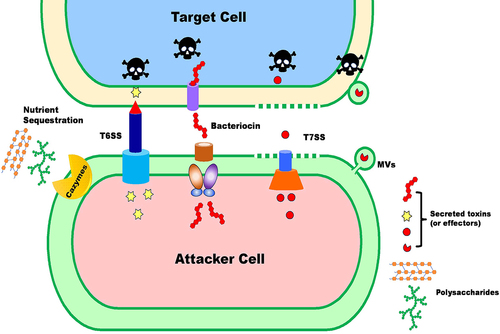Figures & data
Figure 1. Scheme of gut microbial interaction in gut. Bacterial interactions, whether competitive or cooperative, involve a significant investment of energy and stringent regulatory control. Competitive interactions can take the form of exploitation, or interference, while positive interaction mostly related to nutrients cross-feeding and adaptation to environmental stress. Secretion of toxin by contact-dependent or independent manner will confers the bacterial colonization, facilitate niche occupancy, and also eliminate the pathogenic bacteria. Positive interactions among bacteria primarily revolve around optimizing resource utilization and adapting to environmental stresses such as antibiotics or toxins, which will enhance bacterial fitness to complex gut environment.

Figure 2. Main competition machineries in gut microbes. Bacterial competition in the gut can be mediated by contact-dependent secretion systems such as T6SS or T7SS, which lyse neighboring cells by injecting toxic effectors into host cells or the environment. Additionally, bacteria can harm distant cells by releasing bacteriocins directly into the environment or by carrying them via MVs. Moreover, exploiting nutrients in the environment through the direct acquisition or release of enzymes is also an important mode of competition among intestinal bacteria.

Figure 3. Types of positive interactions within gut microbiome. positive interactions are common and important in a population. One species can utilize metabolites produced by another species (a), while different bacteria species can also cross-feed each other by exchanging metabolites(b). (c) bacteria sister cells could provide cross-protection by HGT, biofilm formation and cross feeding response to environmental stressors such as antibiotics or nutrient deficiencies.

